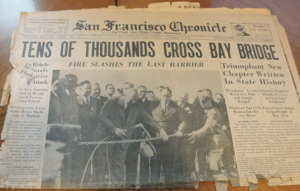So now the new eastern section of the San Francisco Oakland Bay Bridge may not open on time because it is not safe. Even Gov. Jerry Brown finally admits there is a safety problem; guess he does not want the bridge falling into the bay on his watch. The Federal Highway Administration has opened a probe into cracked bolts, and now it turns out thousands of steel rods were left uncovered during construction and may be corroded.
The Bay Bridge fiasco – 24 years since the need to replace the span became apparent in the 1989 Loma Prieta earthquake, and at $6.4 billion in costs, some $5 billion over budget – seems a perfect example of the inability of California to do anything right.
But it wasn’t always this way.
“Tens of Thousands Cross Bay Bridge,” blared the banner headline of the San Francisco Chronicle for November 13, 1936. “Fire Slashes the Last Barrier” captioned the picture of Gov. Frank Merriam using an acetylene torch to cut a golden chain and open the world’s longest bridge.
“Triumphant New Chapter Written in State History,” added the Chronicle in its sub-headline. “Dramatic Link Between Past and Future Forged; Pioneers’ Spirit Is Beaten into Every Rivet,” Chronicle reporter Earle Ennis began his account of the day.
“The bridge that couldn’t be built stands achieved today before an astounded world. Conceived in genius, born of a mighty vision and christened by the faith of its builders, this infant Atlas takes its place among the great things of earth.”
Indeed, the US Steel Corporation, in a Chronicle advertisement, took much of the credit for this mighty Atlas. “The Bridge was started on July 3, 1933 and is finished on scheduled time. It is the world’s largest bridge, 8.25 miles with a length over water of 4.5 miles. It is the world’s costliest bridge, $77,600,000. It required more material than any other bridge in history: 200,000 tons of steel, 1,000,000 cubic yards of concrete, 200,000 gallons of paint.”
This bridge, built at the astounding cost for the time of $77 million, took three years to construct; it has now taken 24 years and more than $6 billion in today’s dollars to fix one of the two spans.
The bridge was approved by the legislature in 1929 when it created the California Toll Bridge Authority, and construction began four years later. But 1933 was the height of the Depression and initially there was no money for the bridge. In 1932, Joseph Knowland, the powerful publisher of the Oakland Tribune, went to Washington and convinced his friend, President Herbert Hoover, and the Reconstruction Finance Corporation to advance $62 million for the bridge.
The bridge was actually named for one of California’s more colorful politicians, Gov. James “Sunny Jim” Rolph who was governor when construction began but died before completion. Sunny Jim got his name during the two decades he was mayor of San Francisco due to his personal theme song, “There are Smiles That Make You Happy.”
Even in the depths of the Depression, Californians could and did smile at the great feat they had achieved. Californians turned the Depression song, “Brother can you spare a dime?” into “Brother did we build a bridge!”
Once we could do those kinds of things.
This article originally appeared in Capitol Morning Report

